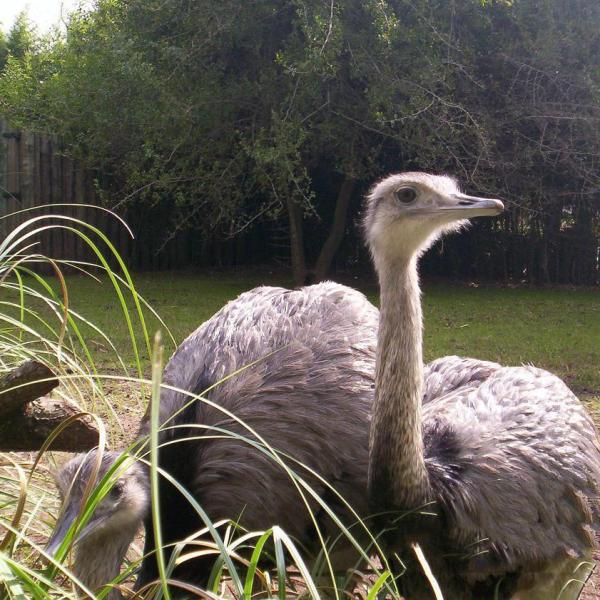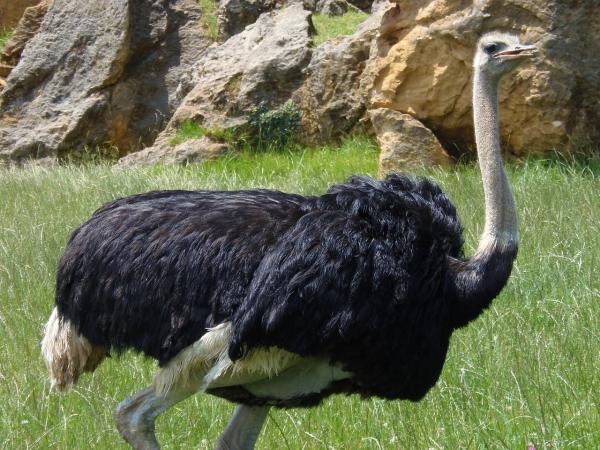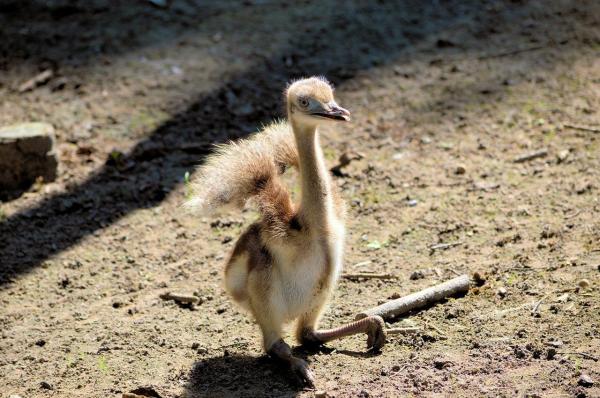
Ostriches, or Struthio camelus, are the largest existing birds on the planet. They live in various sub-Saharan regions of Africa and, given their size and weight, flying is impossible for them. However they are exceptionally good at running.
If you are considering adopting an ostrich as a pet, you will need to have in-depth knowledge about the animal's characteristics and native habitat. Similarly, it is essential to know what type of land is suitable for breeding them in captivity.
Keep reading this AnimalWised article to find out more about this fascinating bird in more detail, so that you can discover whether you can have a pet ostrich.
Domestic ostriches
There are different subspecies of the common ostrich, and not all of them are wild. In fact, the domestic ostrich is a hybrid between two kinds of wild ostrich: the red-necked or North African ostrich and the blue-necked or Somali ostrich.
The red-necked ostrich comes is very endangered, although it is currently being reintroduced in Morocco. Meanwhile, the blue-necked ostrich lives in south-west Africa. This species is not endangered.
This domestic hybrid is the black-necked ostrich or African black ostrich (Struthio camelus var. domesticus). This new breed does not occur in the wilderness.
Domestic ostriches
The black-necked ostrich or domestic ostrich is bred in farms in various countries, as it is excellently acclimatized to different temperature ranges and lands. This species can currently be found in countries such as South Africa, Namibia, Israel, Australia, USA, Canada, Spain, France, Holland, Great Britain, Belgium, Germany, Venezuela, Italy and Ukraine.
There are many reasons for breeding black-necked ostriches. Their meat, eggs, feathers and skin are all considered to be high quality products.

Ostriches as pets
Another reason to breed ostriches that's currently becoming more popular is to adopt and keep ostriches as pets.
A baby ostrich is very easy to find, and this means that many people adopt a hatchling ostrich to satisfy their curiosity of such an exotic bird. However, many people who buy them are unaware of how quickly these birds grow and the latent danger that exists in their powerful legs and claws, which consist of two steel-sharp nails when they become adults.
How big are ostriches?
In the wild, male ostriches can grow up to almost 3 meters (9 feet) in height and weigh 180 kg (almost 400 pounds). They are also very territorial and aggressive animals. Domestic ostriches are somewhat smaller and more docile, but their temperament and relationship with human beings do not make them very compatible as pets.
Ostriches have a small brain in comparison with their body and their responses are very primal. They can confuse a person's friendly approach as an attack, and will defend themselves by kicking the intruder, which can cause serious injury or even death.
How fast do ostriches grow?
Ostriches grow very quickly. When they hatch, they are 25 cm (10 inches) tall and weigh 1 kg (2 pounds). From this moment on they can gain more than 400 grams (about 1 pound) in weight each day. Within two months, they can weigh between 15 and 20 kg (33 to 44 pounds).
When they reach a year or so, ostriches already weigh 100 kg (more than 200 pounds) and continue to grow until reaching adulthood, at around three years old. Obviously, you can only adopt an ostrich if you live in a rural environment or have a very large garden.
The average lifespan of a wild ostrich is 30 to 40 years, while domestic ostriches can live for up to 50 years.

Sexual dimorphism and other features
Male ostriches are different to females ostriches in terms of size and the color of their plumage. A male ostrich's body and stunted wings are covered with black feathers, while females are a dull gray color. In both sexes their long neck and head are covered by sparse whitish down.
Ostriches are very fast animals. They can maintain 90 km (55 miles) per hour when running. One of their eggs equates to the weight of 24 chicken eggs. Each egg weighs 1 to 2 kg (2 to 4 pounds) and the shell is very hard.
Breeding domestic ostriches
Eggs coming from domestic ostriches are not incubated by their parents but in industrial incubators.
If you are intent on adopting an ostrich as a pet, you should know that one way of teaching a baby ostrich to be friendly with a human being is by imprinting. Imprinting is a common phenomenon among birds. When they hatch, they believe the first living creature they see - whether it be a person, a cat, a dog or any other animal - to be their mother.
Baby ostriches will follow their "mother" wherever they go during the first months of their life. This is why if the baby ostrich imprints its adopter when it is born, it will always trust them and will be much easier to train. Moreover, it will also be more obedient.

If you want to read similar articles to Ostriches as Pets: Guidelines and General Tips, we recommend you visit our What you need to know category.